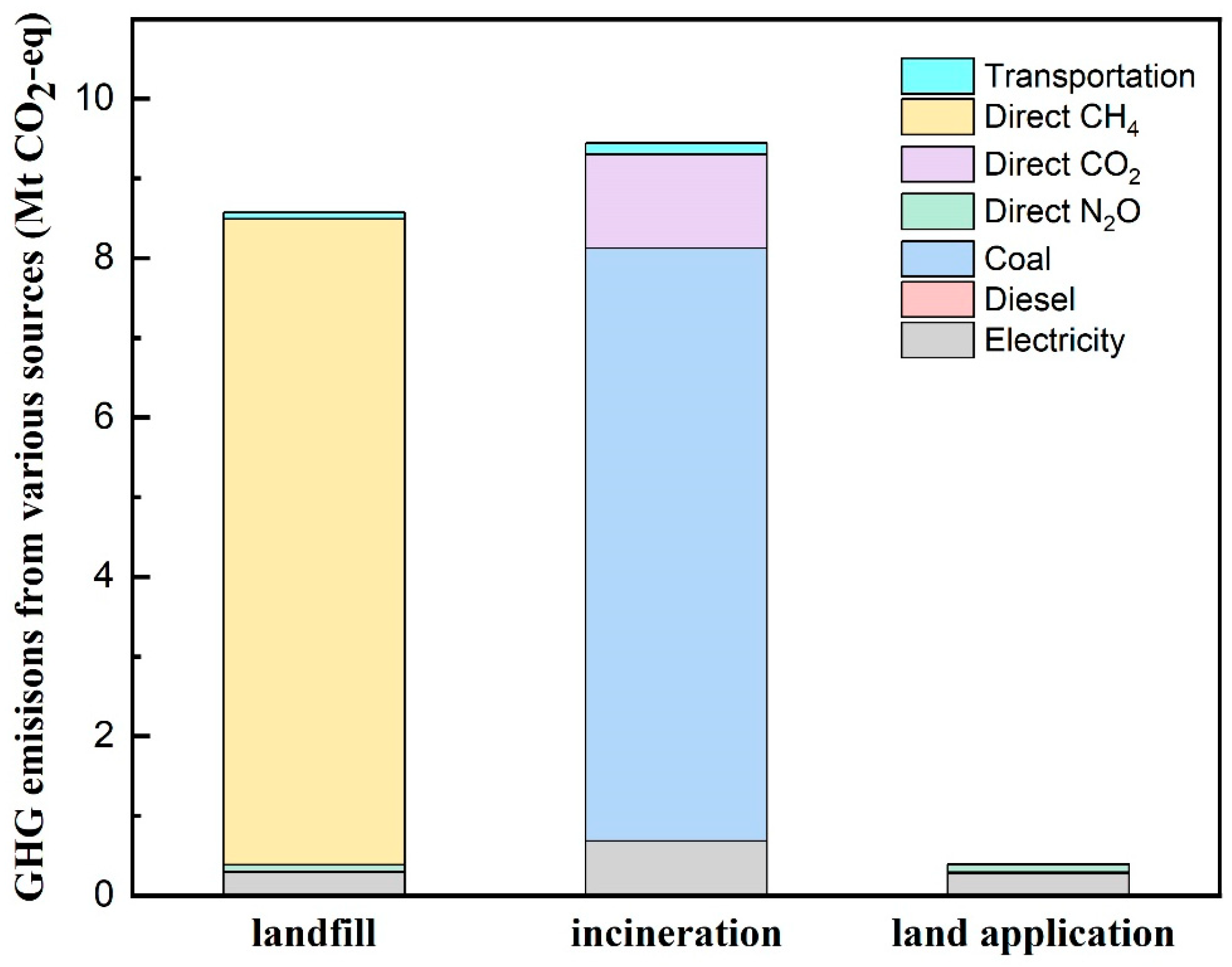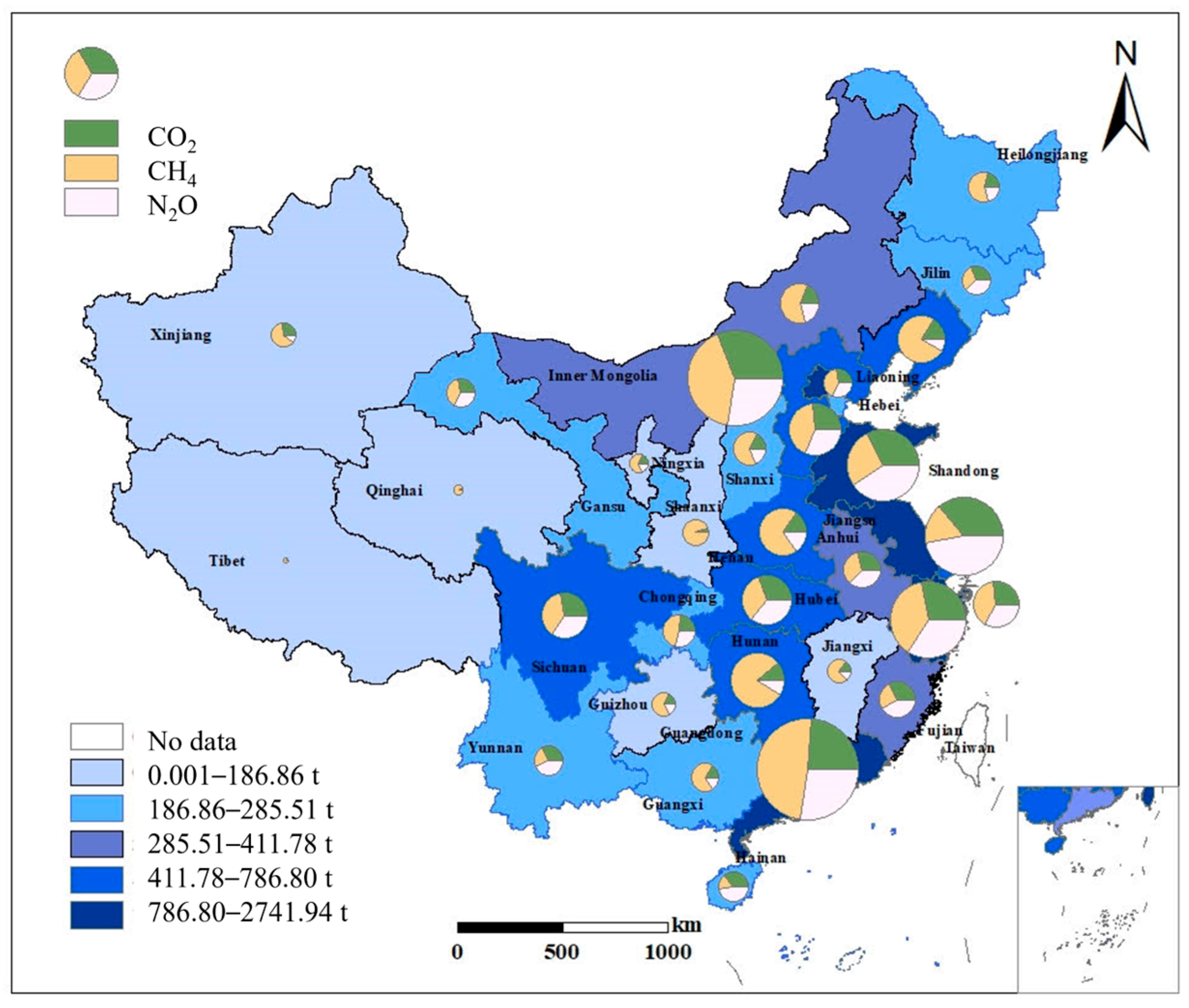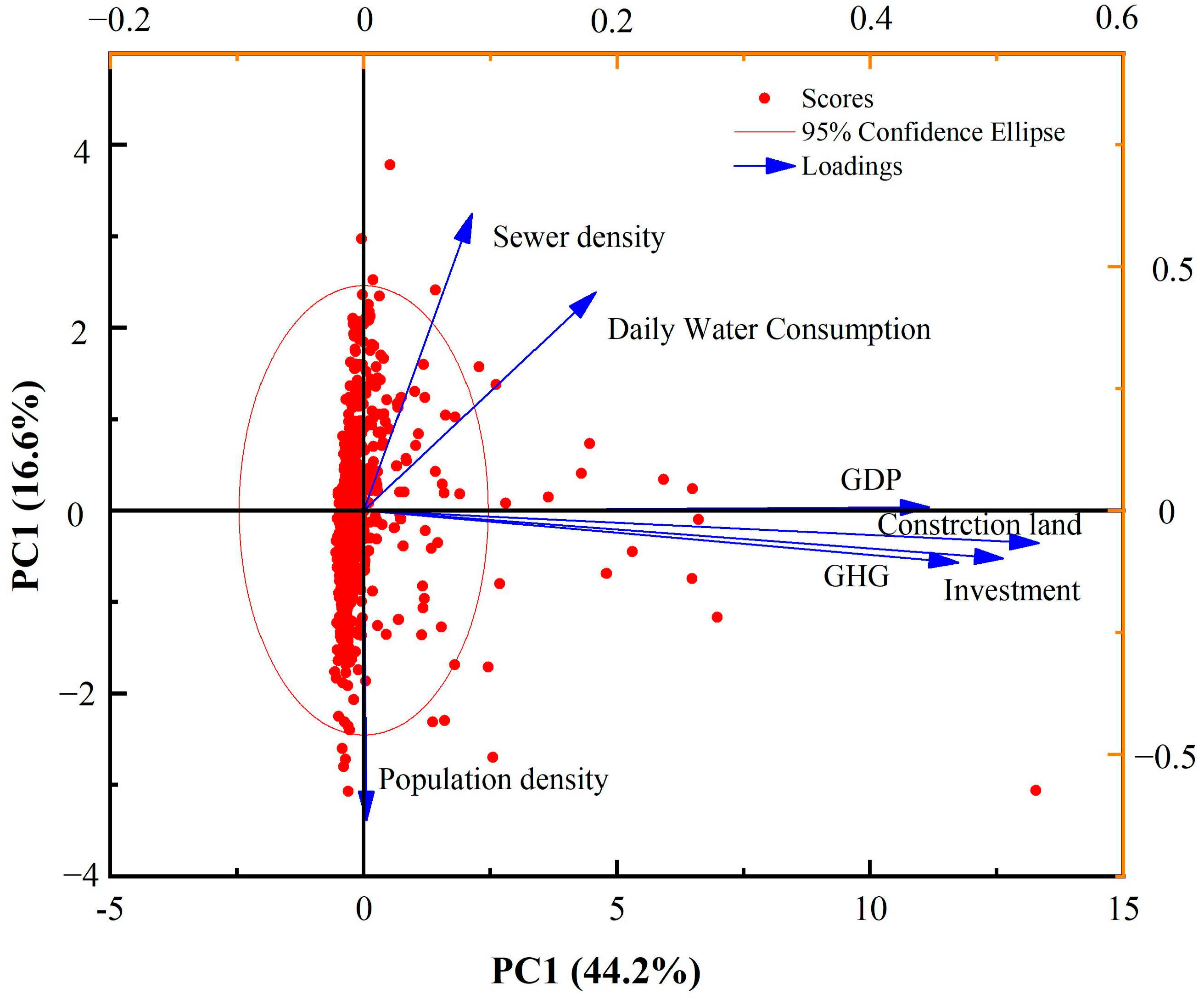Sustainable Sludge Management in China: Quantifying GHG Emissions and Exploring Its Reduction Strategies
Abstract
:1. Introduction
2. Methods
2.1. System Boundary and Data Sources
2.2. GHG Emission Quantifications
2.3. Influencial Factors on GHG Emissions
3. Results and Discussion
3.1. An Overview of the Sludge Treatment Sector
3.2. Characteristics of Carbon Emission
3.3. Impacts of GHG Emissions
4. Potential of GHG Emission Mitigation
5. Conclusions
Author Contributions
Funding
Data Availability Statement
Acknowledgments
Conflicts of Interest
References
- Xu, Y.; Liu, R.; Yang, D.; Dai, X. Sludge treatment and resource recovery towards carbon neutrality in China: Current status and future perspective. Blue-Green Syst. 2021, 3, 119–127. [Google Scholar] [CrossRef]
- Statistical Yearbook of Urban Construction, 2021; Ministry of Ecology and Environment of China: Beijing, China, 2021.
- Wei, L.; Zhu, F.; Li, Q.; Xue, C.; Xia, X.; Yu, H.; Zhao, Q.; Jiang, J.; Bai, S. Development, current state and future trends of sludge management in China: Based on exploratory data and CO2-equivaient emissions analysis. Environ. Int. 2020, 144, 106093. [Google Scholar] [CrossRef]
- Lv, N.; Wang, B.; Wang, H.; Xiao, T.; Dong, B.; Xu, Z. The occurrence characteristics, removal efficiency, and risk assessment of polycyclic aromatic hydrocarbons in sewage sludges from across China. Chemosphere 2024, 351, 141033. [Google Scholar] [CrossRef] [PubMed]
- Liu, Y.; Li, B.; Guo, D.; Munir, M.T.; Song, L.; Wu, X.; Huang, Y. Feasibility of using different hydrothermal processes for sewage sludge management in China. Sci. Total Environ. 2022, 838, 156154. [Google Scholar] [CrossRef] [PubMed]
- Guo, S.; Huang, H.; Dong, X.; Zeng, S. Calculation of greenhouse gas emissions of municipal wastewater treatment and its temporal and spatial trend in China. Water Wastewater Eng. 2019, 45, 56–62. (In Chinese) [Google Scholar]
- Guo, D.; Li, B.; Yu, W.; Han, J.-C.; Zhou, Y.; Ye, Z.; Wu, X.; Young, B.; Huang, Y. Revisiting China’s domestic greenhouse gas emission from wastewater treatment: A quantitative process life-cycle assessment. Sci. Total Environ. 2023, 876, 162597. [Google Scholar] [CrossRef]
- Ding, A.; Zhang, R.; Ngo, H.H.; He, X.; Ma, J.; Nan, J.; Li, G. Life cycle assessment of sewage sludge treatment and disposal based on nutrient and energy recovery: A review. Sci. Total Environ. 2021, 769, 144451. [Google Scholar] [CrossRef]
- Xi, J.; Gong, H.; Zhang, Y.; Dai, X.; Chen, L. The Evaluation of GHG Emissions from Shanghai Municipal Wastewater Treatment Plants Based on IPCC and Operational Data Integrated Methods (ODIM). Sci. Total Environ. 2021, 797, 148967. [Google Scholar] [CrossRef] [PubMed]
- Kumar, A.; Thanki, A.; Padhiyar, H.; Singh, N.K.; Pandey, S.; Yadav, M.; Yu, Z.-G. Greenhouse gases emission control in WWTS via potential operational strategies: A critical review. Chemosphere 2021, 273, 129694. [Google Scholar] [CrossRef]
- Tarpani, R.R.Z.; Azapagic, A. Life cycle sustainability assessment of advanced treatment techniques for urban wastewater reuse and sewage sludge resource recovery. Sci. Total Environ. 2023, 869, 161771. [Google Scholar] [CrossRef]
- Zhou, H.; Zhang, W.; Li, L.; Zhang, M.; Wang, D. Environmental impact and optimization of lake dredged-sludge treatment and disposal technologies based on life cycle assessment (LCA) analysis. Sci. Total Environ. 2021, 787, 147703. [Google Scholar] [CrossRef]
- Nkuna, S.G.; Olwal, T.O.; Chowdhury, S.D.; Ndambuki, J.M. A review of wastewater sludge-to-energy generation focused on thermochemical technologies: An improved technological, economical and socio-environmental aspect. Clean. Waste Syst. 2024, 7, 100130. [Google Scholar] [CrossRef]
- Janaszek, A.; da Silva, A.F.; Jurišević, N.; Kanuchova, M.; Kozáková, Ľ.; Kowalik, R. The Assessment of Sewage Sludge Utilization in Closed-Loop Economy from an Environmental Perspective. Water 2024, 16, 383. [Google Scholar] [CrossRef]
- Yuan, H.; Zhai, S.; Fu, H.; Li, Z.; Gao, D.; Zhu, H. Environmental and economic life cycle assessment of emerging sludge treatment routes. J. Clean. Prod. 2024, 449, 141792. [Google Scholar] [CrossRef]
- Huang, D.; Wu, Y.; Zhang, L.; Tang, Y.; Liu, C.; Zhang, R.; Wang, Y.; Gao, Y. Life cycle assessment of sewage sludge treatment and disposal technologies based on carbon emissions and environmental impacts. Environ. Technol. 2024. [Google Scholar] [CrossRef] [PubMed]
- Ferrentino, R.; Langone, M.; Fiori, L.; Andreottola, G. Full-Scale Sewage Sludge Reduction Technologies: A Review with a Focus on Energy Consumption. Water 2023, 15, 615. [Google Scholar] [CrossRef]
- Di Fraia, S.; Massarotti, N.; Vanoli, L.; Costa, M. Thermo-economic analysis of a novel cogeneration system for sewage sludge treatment. Energy 2016, 115, 1560–1571. [Google Scholar] [CrossRef]
- Wang, Z.; Li, X.; Liu, H.; Li, J.; Vodnar, D.C.; Lin, C.S.K.; Wang, Q. Life cycle assessment of traditional and innovative sludge management scenarios in Australia: Focusing on environmental impacts, energy balance, and economic benefits. Resour. Conserv. Recycl. 2024, 204, 107496. [Google Scholar] [CrossRef]
- SYUC Statistical Yearbook of Urban Construction. 2018. Available online: https://www.mohurd.gov.cn/file/old/2020/20200327/w02020032722244243052500000.xls (accessed on 6 January 2018).
- Ministry of Ecological Environment. 2017. Available online: http://www.tanjiaoyi.com/article-25419-1.html (accessed on 21 December 2018).
- Shrestha, A.; Bhattarai, T.N.; Ghimire, S.; Mainali, B.; Treichel, H.; Paudel, S.R. Estimation of greenhouse gases emission from domestic wastewater in Nepal: A scenario-based analysis applicable for developing countries. Chemosphere 2022, 300, 134501. [Google Scholar] [CrossRef]
- Yin, Z.; Toucai, Z.; Hongjiang, L. Predictive method research of sludge landfills gas production. China Environ. Sci. 2010, 30, 204–208. (In Chinese) [Google Scholar]
- Hong, J.; Hong, J.; Otaki, M.; Jolliet, O. Environmental and economic life cycle assessment for sewage sludge treatment processes in Japan. Waste Manag. 2009, 29, 696–703. [Google Scholar] [CrossRef]
- IPCC. 2007 IPCC Guidelines for National Greenhouse Gas Inventories; IPCC: Geneva, Switzerland, 2007. [Google Scholar]
- Liu, H.T.; Zheng, H.X.; Chen, T.B.; Zheng, G.D.; Gao, D. Reduction in greenhouse gas emissions from sewage sludge aerobic compost in China. Water Sci. Technol. 2014, 69, 1129–1135. [Google Scholar] [CrossRef] [PubMed]
- Liu, B.; Wei, Q.; Zhang, B.; Bi, J. Life cycle GHG emissions of sewage sludge treatment and disposal options in Tai Lake Watershed, China. Sci. Total Environ. 2013, 447, 361–369. [Google Scholar] [CrossRef] [PubMed]
- Chen, Y.C.; Kuo, J. Potential of greenhouse gas emissions from sewage sludge management: A case study of Taiwan. J. Clean. Prod. 2016, 129, 196–201. [Google Scholar] [CrossRef]
- IPCC. 2006 IPCC Guidelines for National Greenhouse Gas Inventories. Intergovernmental Panel on Climate Change, Japan; IPCC: Geneva, Switzerland, 2006. [Google Scholar]
- Murray, A.; Horvath, A.; Nelson, K.L. Hybrid life-cycle environmental and cost inventory of sewage sludge treatment and end-use scenarios: A case study from China. Environ. Sci. Technol. 2008, 42, 3163–3169. [Google Scholar] [CrossRef]
- Li, Y.; Chen, Y.; Wu, J. Enhancement of methane production in anaerobic digestion process: A review. Appl. Energy 2019, 240, 120–137. [Google Scholar] [CrossRef]
- Zhang, Q.H.; Yang, W.N.; Ngo, H.H.; Guo, W.S.; Jin, P.K.; Dzakpasu, M.; Yang, S.J.; Wang, Q.; Wang, X.C.; Ao, D. Current status of urban wastewater treatment plants in China. Environ. Int. 2016, 92–93, 11–22. [Google Scholar] [CrossRef]
- Twagirayezu, E.; Fan, L.; Liu, X.; Iqbal, A.; Lu, X.; Wu, X.; Zan, F. Comparative life cycle assessment of sewage sludge treatment in Wuhan, China: Sustainability evaluation and potential implications. Sci. Total Environ. 2024, 913, 169686. [Google Scholar] [CrossRef]
- Xiao, L.; Lin, T.; Wang, Y.; Ye, Z.; Liao, J. Comparative life cycle assessment of sludge management: A case study of Xiamen, China. J. Clean. Prod. 2018, 192, 354–363. [Google Scholar]
- Zhang, H.; Rigamonti, L.; Visigalli, S.; Turolla, A.; Gronchi, P.; Canziani, R. Environmental and economic assessment of electro-dewatering application to sewage sludge: A case study of an Italian wastewater treatment plant. J. Clean. Prod. 2019, 210, 1180–1192. [Google Scholar] [CrossRef]
- Pradel, M.; Reverdy, A.L. Assessing GHG Emissions from Sludge Treatment and Disposal Routes: The Method behind GESTABoues Tool. 2020. Available online: https://hal.science/hal-00781673 (accessed on 6 January 2018).
- Nakakubo, T.; Yoshida, N.; Hattori, Y. Analysis of greenhouse gas emission reductions by collaboratively updating equipment in sewage treatment and municipal solid waste incineration plants. J. Clean. Prod. 2017, 168, 803–813. [Google Scholar] [CrossRef]
- Chen, W.; Liu, J.; Zhu, B.-H.; Shi, M.-Y.; Zhao, S.-Q.; He, M.-Z.; Yan, P.; Fang, F.; Guo, J.-S.; Li, W.; et al. The GHG mitigation opportunity of sludge management in China. Environ. Res. 2022, 212, 113284. [Google Scholar] [CrossRef] [PubMed]
- Guo, D.; Li, B.; Yu, W.; Baroutian, S.; Young, B.R. A system engineering perspective for net zero carbon emission in wastewater and sludge treatment industry: A review. Sustain. Prod. Consum. 2024, 46, 369–381. [Google Scholar] [CrossRef]
- Huang, Y.; Zhen, Y.; Liu, L.; Ning, X.; Wang, C.; Li, K.; Zhao, L.; Lu, Q. Comprehensive competitiveness assessment of four typical municipal sludge treatment routes in China based on environmental and techno-economic analysis. Sci. Total Environ. 2023, 895, 141792. [Google Scholar] [CrossRef] [PubMed]
- Hao, X.; Chen, Q.; van Loosdrecht, M.C.; Li, J.; Jiang, H. Sustainable disposal of excess sludge: Incineration without anaerobic digestion. Water Res. 2020, 170, 115298. [Google Scholar] [CrossRef] [PubMed]
- Gahlot, P.; Balasundaram, G.; Tyagi, V.K.; Atabani, A.; Suthar, S.; Kazmi, A.; Štěpanec, L.; Juchelková, D.; Kumar, A. Principles and potential of thermal hydrolysis of sewage sludge to enhance anaerobic digestion. Environ. Res. 2022, 214, 113856. [Google Scholar] [CrossRef]
- Yin, Z.; Wang, J.; Wang, M.; Liu, J.; Chen, Z.; Yang, B.; Zhu, L.; Yuan, R.; Zhou, B.; Chen, H. Application and improvement methods of sludge alkaline fermentation liquid as a carbon source for biological nutrient removal: A review. Sci. Total Environ. 2023, 873, 162341. [Google Scholar] [CrossRef]






| Activity | Value | Unit | Activity | Value | Unit |
|---|---|---|---|---|---|
| Landfills CH4 | 60.6 | kg CO2-eq/t DS | N2O from diesel truck | 1.4 × 10−4 | kg CH4/L diesel |
| Landfills biogenic CO2 | 17.2 | kg CO2-eq/t DS | CO2 from diesel | 7.4 × 10−2 | kg CO2/L diesel |
| CH4 from incineration | 0.049 | kg CO2-eq/t DS | CH4 from diesel | 2.5 × 10−5 | kg CH4/L diesel |
| N2O from incineration | 0.99 | kg CO2-eq/t DS | N2O from diesel | 4.5 × 10−4 | kg N2O/L diesel |
| CO2 from aerobic composting | 210 | kg CO2-eq/t DS | Electricity consumption | 0.785 | kg CO2/kWh |
| Fertilizer avoided CO2 | −66.8 | kg CO2-eq/t DS | CO2 from coal | 0.098 | kg CO2/MJ |
| CO2 from diesel truck | 2.6 | kg CO2/L diesel | CH4 from coal | 0.25 × 10−4 | kg CH4/MJ |
| CH4 from diesel truck | 1.4 × 10−4 | kg CH4/L diesel | N2O from coal | 0.45 × 10−3 | kg N2O/MJ |
| Region | Total Amount | CO2 | CH4 | N2O |
|---|---|---|---|---|
| Northern | 6176.14 | 5148.80 | 902.83 | 124.51 |
| Eastern | 5836.77 | 4969.63 | 774.10 | 93.04 |
| Central | 5209.68 | 4418.78 | 726.02 | 64.88 |
| Southern | 4805.19 | 4195.72 | 568.49 | 40.98 |
| Northeastern | 1520.52 | 1307.16 | 202.25 | 11.11 |
| Northwestern | 1122.65 | 933.83 | 162.53 | 26.29 |
| Methods | Reduction Potential (t CO2-eq/t DS) | Cost (USD/t DS) | Typical Capacity (t DS/Day) | Reactor Type | Benefits | Cost (USD/t DS) | References |
|---|---|---|---|---|---|---|---|
| Gasification | 0.33–0.46 | 200–400 | 10–100 | Fixed bed, fluidized bed, and entrained flow |
| 200–400 | [33] |
| AD | 0.09–0.30 | 100–200 | 5–50 | Continuous stirred tank, upflow anaerobic sludge blanket, and AnMBR |
| 100–200 | [5,38] |
| HTP | 0.20–0.40 | 300–500 | 1–20 | Batch reactor and continuous flow reactor |
| 300–500 | [5,34] |
| WO | 0.10–0.30 | 150–300 | 1–20 | Batch reactor and continuous flow reactor |
| 150–300 | [15,39] |
| Pyrolysis | 0.15–0.30 * | 250–450 | 1–50 | Rotary kiln, fluidized bed, and screw reactor |
| 250–450 | [5,40] |
Disclaimer/Publisher’s Note: The statements, opinions and data contained in all publications are solely those of the individual author(s) and contributor(s) and not of MDPI and/or the editor(s). MDPI and/or the editor(s) disclaim responsibility for any injury to people or property resulting from any ideas, methods, instructions or products referred to in the content. |
© 2024 by the authors. Licensee MDPI, Basel, Switzerland. This article is an open access article distributed under the terms and conditions of the Creative Commons Attribution (CC BY) license (https://creativecommons.org/licenses/by/4.0/).
Share and Cite
Hu, D.; Jiang, P.; Chen, Y.; Gao, F.; Liu, S. Sustainable Sludge Management in China: Quantifying GHG Emissions and Exploring Its Reduction Strategies. Processes 2024, 12, 1481. https://doi.org/10.3390/pr12071481
Hu D, Jiang P, Chen Y, Gao F, Liu S. Sustainable Sludge Management in China: Quantifying GHG Emissions and Exploring Its Reduction Strategies. Processes. 2024; 12(7):1481. https://doi.org/10.3390/pr12071481
Chicago/Turabian StyleHu, Dongming, Peng Jiang, Yipei Chen, Fuyan Gao, and Shuai Liu. 2024. "Sustainable Sludge Management in China: Quantifying GHG Emissions and Exploring Its Reduction Strategies" Processes 12, no. 7: 1481. https://doi.org/10.3390/pr12071481







